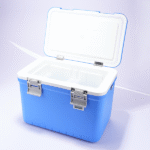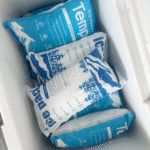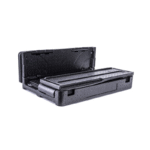Trockeneisbeutel für Versandbehälter: So gewährleisten Sie einen sicheren und effizienten Versand
Trockeneisbeutel für Versandbehälter sind entscheidend, um temperaturempfindliche Güter während des Transports in optimalen Bedingungen zu halten. Ob Sie Pharmazeutika versenden, verderbliche Lebensmittel, oder hochwertige Chemikalien, Trockeneis sorgt für die nötige Kühlleistung, um die Produktintegrität zu bewahren. In diesem Artikel werden die Vorteile von Trockeneis in der Schifffahrt untersucht, sein Mechanismus bei der Temperaturregulierung, Best Practices für die Sicherheit, und wie man die effizientesten und konformsten Versandprozesse gewährleistet.

-
Welche Vorteile bietet die Verwendung von Trockeneisbeuteln in Versandbehältern??
-
Wie halten Trockeneisbeutel die Temperatur während des Transports aufrecht??
-
Was sind die besten Praktiken für den Einsatz von Trockeneis in der Containerschifffahrt??
-
So stellen Sie die Einhaltung der Sicherheitsvorschriften beim Versand mit Trockeneis sicher?
Welche Vorteile bietet die Verwendung von Trockeneisbeuteln in Versandbehältern??
Trockeneisbeutel sind aufgrund ihrer einzigartigen Eigenschaften, die bei Langstreckentransporten für eine gleichmäßige und effiziente Kühlung sorgen, eine beliebte Lösung in Versandbehältern. Durch direkte Sublimation in Gas, Trockeneis eliminiert das Risiko von Wasserschäden, die andere Kühlmittel verursachen könnten. Nachfolgend sind die wichtigsten Vorteile aufgeführt, die Trockeneis zu einer optimalen Wahl für die Kühlkettenlogistik machen:
Hauptvorteile:
-
Lang anhaltende Kühlung: Trockeneis hält über einen längeren Zeitraum eine konstant niedrige Temperatur aufrecht, Dies ist ideal für Sendungen, die mehrere Tage lang kalt bleiben müssen.
-
Leicht und effizient: Im Gegensatz zu herkömmlichem Eis, Trockeneis nimmt weniger Platz ein, was sich in einem geringeren Versandgewicht und geringeren Kosten niederschlägt.
-
Keine Wasserrückstände: Da Trockeneis direkt zu Gas sublimiert, es hinterlässt kein Wasser, Vermeidung möglicher Schäden an den Produkten und der Verpackung.
| Vorteil | Beschreibung | Praktische Implikationen |
|---|---|---|
| Lang anhaltende Kühlung | Hält niedrige Temperaturen über längere Zeiträume aufrecht | Ideal für lange Versanddauern |
| Leicht & Effizient | Kompakt und reduziert das Versandgewicht | Hilft, Transportkosten zu senken |
| Keine Wasserrückstände | Sublimates zu Gas, hinterlässt keine Feuchtigkeit | Hält Produkte und Verpackungen sauber |
Praktische Tipps und Empfehlungen für Benutzer
-
Für Arzneimittel: Trockeneis ist unerlässlich, um die Wirksamkeit temperaturempfindlicher Medikamente und Impfstoffe bei weltweiten Lieferungen aufrechtzuerhalten.
-
Für verderbliche Lebensmittel: Artikel wie frische Meeresfrüchte, Fleisch, und andere verderbliche Güter, die konstante kalte Temperaturen erfordern, profitieren stark von der Verwendung von Trockeneis.
-
Für Chemikalien: Bestimmte Chemikalien, insbesondere in der Forschung und Biotechnologie, eine präzise Temperaturregulierung benötigen. Trockeneis sorgt dafür, dass diese Produkte während des Transports stabil bleiben.
Wie halten Trockeneisbeutel die Temperatur während des Transports aufrecht??
Trockeneisbeutel funktionieren, indem sie direkt in CO₂-Gas sublimieren, Erzeugen eines Kühleffekts im Inneren von Versandbehältern. Der Kühlprozess ist für die Konservierung empfindlicher Waren, die Temperaturen unter dem Gefrierpunkt erfordern, unerlässlich. So funktioniert Trockeneis in der Schifffahrt:
Temperaturkontrollmechanismus:
-
Direkte Sublimation: Als Trockeneis untermüßt Gas, Es kühlt die umgebende Luft, Dadurch bleiben die Temperaturen im Inneren des Behälters niedrig.
-
Isolierte Verpackung: Richtig isolierte Behälter sorgen dafür, dass das Trockeneis nicht zu schnell sublimiert, Verlängerung der Kühldauer.
-
Maßgeschneiderte Trockeneismengen: Die Menge des verwendeten Trockeneises hängt von der Größe der Sendung und den Temperaturanforderungen der Produkte ab.
| Einrichtung des Versandcontainers | Hauptmerkmal | Wirksamkeit |
|---|---|---|
| Richtige Isolierung | Verhindert, dass Trockeneis zu schnell sublimiert | Maximiert die Kühldauer |
| Individuelle Trockeneismenge | Basierend auf der Sendungsgröße angepasst | Gewährleistet eine ausreichende Kühlung der Produkte |
| Belüftung | Ermöglicht das sichere Entweichen von CO₂-Gas | Verhindert einen gefährlichen Druckaufbau |
Best Practices für den Einsatz von Trockeneis in der Containerschifffahrt
Um die Temperaturanforderungen Ihrer Sendung zu erfüllen, ist es von entscheidender Bedeutung, dass Trockeneisbeutel effizient funktionieren. Nachfolgend finden Sie einige Best Practices für die Verwendung von Trockeneis in Versandbehältern:
-
Richtige Trockeneismenge: Verwenden Sie ungefähr 1 Zu 2 Pfund Trockeneis pro 10–15 Pfund Produkt für jeden 24-Stunden-Zeitraum.
-
Effektive Isolierung: Eine ordnungsgemäße Isolierung des Versandbehälters ist entscheidend für die Verlangsamung der Sublimationsrate von Trockeneis, um sicherzustellen, dass es länger hält.
-
Belüftung sicherstellen: Damit CO₂-Gas sicher entweichen kann, ist eine ordnungsgemäße Belüftung erforderlich. Ohne ausreichende Belüftung, das CO₂ kann sich ansammeln, Dies kann möglicherweise zu gefährlichen Bedingungen führen.
Sicherheitsaspekte bei der Verwendung von Trockeneis in Versandbehältern
Der Umgang mit Trockeneis ist nicht ohne Risiken. Wenn CO₂ zu Gas sublimiert, Dies kann zum Ersticken oder zu einem Druckaufbau im Versandbehälter führen. Im Folgenden finden Sie wichtige Sicherheitsmaßnahmen zur Minderung dieser Risiken:
Sicherheitstipps für den Umgang mit Trockeneis:
-
Schutzausrüstung tragen: Verwenden Sie immer isolierte Handschuhe, Brille, Tragen Sie beim Umgang mit Trockeneis lange Ärmel, um Erfrierungen und Verbrennungen zu vermeiden.
-
Stellen Sie eine ordnungsgemäße Belüftung sicher: Versandbehälter müssen das Entweichen von CO₂-Gas ermöglichen. Eine schlechte Belüftung kann zu einem gefährlichen Druckaufbau führen.
-
Ausbildung: Jeder, der mit Trockeneis umgeht, sollte ausreichend über die Risiken und die richtigen Handhabungsverfahren geschult werden, um die Sicherheit während des gesamten Versandprozesses zu gewährleisten.
2025 Trends bei Trockeneisbeuteln für Versandbehälter
Da sich die Kühlkettenlogistikbranche ständig weiterentwickelt, Dies gilt auch für die Verwendung von Trockeneis in Schiffscontainern. Hier sind die neuesten Trends und Entwicklungen, die diesen Bereich prägen 2025:
Trendübersicht:
-
Nachhaltigkeit: Es wird immer mehr Wert auf die Beschaffung von umweltfreundlichem Trockeneis und die Verwendung nachhaltiger Verpackungsmaterialien gelegt, getrieben durch Verbraucher- und Regulierungsdruck.
-
Vorschriftenregulierung: Die Schifffahrtsbranche stellt sich auf neue Vorschriften ein, deren Schwerpunkt auf der Verbesserung der Transparenz und Sicherheit beim Transport von Arzneimitteln liegt, Essen, und medizinische Versorgung.
-
Automatisierung in der Logistik: KI und IoT gewinnen in Logistiklösungen zunehmend an Bedeutung, Verbesserung der Genauigkeit und Effizienz von Trockeneislieferungen bei gleichzeitiger Minimierung der Umweltauswirkungen.
Neueste Entwicklungen auf einen Blick:
-
Nachhaltigkeit: Der Schwerpunkt liegt auf der Trockeneisproduktion mit erneuerbarer Energie und umweltfreundlichen Verpackungsmaterialien.
-
KI-gesteuerte Optimierung: Künstliche Intelligenz hilft Unternehmen, Trockeneislieferungen zu optimieren, Verbesserung der Routenplanung und Minimierung des CO2-Fußabdrucks.
-
Regulatorische Aktualisierungen: Neue IATA- und DOT-Vorschriften mit Schwerpunkt auf Nachhaltigkeit und aktualisierte Verpackungs- und Kennzeichnungsanforderungen.
Häufige Fragen zu Trockeneisbeuteln in Versandbehältern
Q1: Wie lange ist Trockeneis in einem Versandbehälter haltbar??
A1: Trockeneis kann bis zu dauern 72 Std., abhängig von der Art des Behälters und der verwendeten Isolierung. Für längere Sendungen, Möglicherweise ist mehr Trockeneis erforderlich.
Q2: Ist die Verwendung von Trockeneis in Versandbehältern für Lebensmittel sicher??
A2: Ja, Trockeneis wird häufig zum Versand von Lebensmitteln verwendet. Um die Frische zu bewahren, ist es wichtig, eine ordnungsgemäße Abdichtung und Isolierung sicherzustellen.
Schlussfolgerung und Empfehlungen
Zusammenfassend, Trockeneisbeutel für Versandcontainer sind eine zuverlässige und effiziente Möglichkeit, um sicherzustellen, dass Ihre temperaturempfindlichen Waren während des Transports im erforderlichen Temperaturbereich bleiben. Durch die Verwendung der richtigen Menge Trockeneis, Einsatz wirksamer Isolierung, und Befolgen bewährter Sicherheitspraktiken, Sie können die Integrität Ihrer Sendungen sicherstellen.
Nächste Schritte: Wenn Sie planen, temperaturempfindliche Waren zu versenden, Ziehen Sie in Betracht, einen Logistikexperten zu konsultieren, um Ihren Trockeneisverbrauch zu optimieren und die Einhaltung aller Sicherheitsvorschriften sicherzustellen.
Über Tempk
Und Tempk, Wir sind spezialisiert auf Kaltketten -Logistiklösungen, einschließlich Trockeneisbeutel für Versandbehälter. Unsere Produkte sind darauf ausgelegt, Ihre Waren während des Transports in optimalem Zustand zu halten, Wir bieten zuverlässige und nachhaltige Lösungen für Unternehmen in Branchen wie der Pharmaindustrie, Essen, und Biotechnologie.
Aufruf zum Handeln: Kontaktieren Sie uns noch heute, um zu erfahren, wie wir Sie bei der Optimierung Ihrer Versandprozesse mit unseren Trockeneislösungen unterstützen können.























